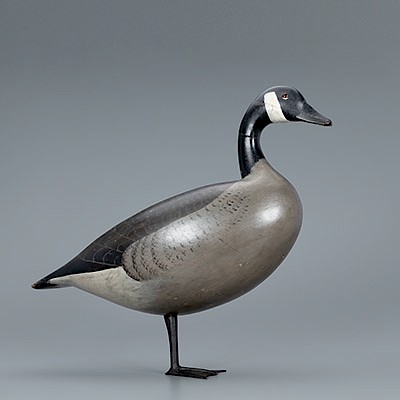Early Hollow Running Curlew
Lot 168
About Seller
Copley Fine Art Auctions
20 Winter Street
Pembroke, MA 02359
United States
Founded in 2005, Copley Fine Art Auctions is a boutique auction house specializing in antique decoys and American, sporting, and wildlife paintings. Over the course of the last two decades, the firm has set auction records for not only individual decoy makers, but also entire carving regions. Copley...Read more
Estimate:
$70,000 - $80,000
Absentee vs Live bid
Two ways to bid:
- Leave a max absentee bid and the platform will bid on your behalf up to your maximum bid during the live auction.
- Bid live during the auction and your bids will be submitted real-time to the auctioneer.
Bid Increments
| Price | Bid Increment |
|---|---|
| $0 | $50 |
| $1,000 | $100 |
| $2,500 | $250 |
| $5,000 | $500 |
| $10,000 | $1,000 |
| $25,000 | $2,500 |
| $50,000 | $5,000 |
About Auction
By Copley Fine Art Auctions
Feb 16, 2019
Set Reminder
2019-02-16 10:00:00
2019-02-16 10:00:00
America/New_York
Bidsquare
Bidsquare : The Winter Sale 2019
https://www.bidsquare.com/auctions/copley/the-winter-sale-2019-3820
The sale will offer the opportunity to view and take home world-class paintings and fine bird carvings. Featuring selections from the collections of Alfred Ely, L. H. LaMonte, Grant Nelson, Ronald S. Swanson, Herb Wetanson, and a descendant of Chester F. Spear among others. Copley Fine Art Auctions cinnie@copleyart.com
The sale will offer the opportunity to view and take home world-class paintings and fine bird carvings. Featuring selections from the collections of Alfred Ely, L. H. LaMonte, Grant Nelson, Ronald S. Swanson, Herb Wetanson, and a descendant of Chester F. Spear among others. Copley Fine Art Auctions cinnie@copleyart.com
- Lot Description
Early Hollow Running Curlew
Massachusetts, c. 1850
19 1/4 in. long
“When I received the postcard announcement of his annual Veterans’ Day Americana auction from Carl R. Nordblom, the Cambridge Massachusetts Auctioneer, my eye was caught by a split-tailed curlew amidst the jumble of chairs, chests, and china. It looked good enough to lure me to the jam-packed viewing room at the Holiday Inn in Dedham, Massachusetts. When I asked to see the curlew it was brought to me in a carton with the head separated from the body, and they ordered me to ‘Handle it with care and don't try to assemble it!’ I didn't have to. It was splendid, and in good condition, one of the best curlews I had ever seen.” -Jackson Parker, Decoy Magazine, 1997
Every so often, the unearthing of a singular decoy captures the imaginations of the decoy and folk art collecting communities. Such is the story of this curlew. In 1997 Decoy Magazine described this one-of-a-kind decoy as “one of the best curlew decoys we’ve seen.”
The first major decoy collector to acquire this bird was Thomas K. Figge. The Figge Collection consisted of over one hundred waterfowl decoys and is revered as one of the finest collections ever assembled. Though primarily focused on ducks and geese, Mr. Figge made three important shorebird acquisitions: this reaching decoy, a Phillips rig running curlew, and a rig of Nantucket curlew. During its tenure in the Figge Collection, this bird was selected for the “One Hundred Greatest” book. Discussing the decoy, Figge recounts: “When Stevie called me about this bird I could tell by his voice that it was worth checking out. Though shorebirds were in no way my primary pursuit, I asked to see some photos. When they arrived in the mail, I was immediately intrigued. The bird was big and bold, not like most shorebirds I had seen. I told him to buy it.”
As with many great decoys, this curlew possesses a powerful presence. Fashioned in a running pose, it measures over nineteen inches from the tip of the delicate octagonal bill to the classic “Lincolnesque” split-tail carving.
One of the longest shorebirds known, it reveals a multiple of nuances that engage the viewer. Its glass eyes are set within deep eye grooves that give the sculpture a compelling gaze. The detachable head, when aligned correctly, is not only fully extended, but also slightly turned and cocked. The chine of the throat imparts movement to the decoy’s out-stretched neck. Freely resting on a dowel, the removable head is fashioned for ease of transport, similar to the Dovetailed geese and shorebirds. This rare feature speaks to the improbability of the head and body remaining together for over 150 years. Ironically, it was this give in the neck that kept the delicate bill intact over the years. The thoughtful maker went to lengths to create a lighter gunning model, hollowing the two-piece body. The curlew’s plumage is addressed from tip to tail with light-on-dark and dark-on-light stippling; these merge seamlessly in front of the high-contrast wing delineation. The underside retains the “NELSON” collection stamp. Original paint with even gunning wear and minor darkening to flaking.
Provenance: Thomas K. Figge Collection, acquired 1997
Grant Nelson Collection
Literature: Loy S. Harrell, Jr., "Decoys: North America’s One Hundred Greatest," Iola, WI, 2000, p. 82, exact decoy illustrated.
Jackson Parker, "Unknown Curlew Causes Excitement at Massachusetts Americana Auction," Decoy Magazine, November/December 1997, pp. 3 and 34, exact decoy illustrated twice.Condition report requests can be made via email or by telephone (info@copleyart.com or 617.536.0030). Any condition statement given is a courtesy to customers, Copley will not be held responsible for any errors or omissions. The absence of a condition statement does not imply that the lot is in perfect condition.Condition
- Shipping Info
-
Shipping info
Copley Fine Art Auctions does not handle the shipping of any items. Shipping is the sole responsibility of the buyer. Once your payment has cleared, and we have received your authorized shipping release form items may be released for shipment. Copley Fine Art Auctions, LLC shall have no liability for any loss or damage to such items. Buyers should allow up to four weeks for shipment.Please be aware that internet bidders may NOT not pick up their items at the sale. Items will be available for pick up by appointment or by shippers five days after the sale.
-



 EUR
EUR CAD
CAD AUD
AUD GBP
GBP MXN
MXN HKD
HKD CNY
CNY MYR
MYR SEK
SEK SGD
SGD CHF
CHF THB
THB















